Ancient Origins
The history of terrestrial globes dates back to ancient civilizations, with the earliest known versions dating back to the 3rd century BC. These early globes were not as we know them today, but rather simple representations of the Earth’s surface. The Greeks, Egyptians, and Chinese all had their own versions of globes, most commonly made of stone or wood.
The Greek philosopher Crates of Mallus is often credited with creating the first known terrestrial globe. He created a globe based on the work of earlier Greek astronomers and geographers, such as Eratosthenes and Hipparchus. This early globe was a spherical representation of the Earth’s surface, with the known continents and bodies of water depicted.
Medieval Developments
During the Middle Ages, the knowledge of globes was kept alive in the Islamic world. Islamic scholars, such as Al-Idrisi and Ibn Hawqal, made significant advancements in cartography and created detailed maps and globes. These globes were often works of art, intricately crafted and adorned with calligraphy and decorative motifs.
In Europe, the knowledge of globes was largely lost during the Dark Ages. However, with the revival of learning in the Renaissance period, there was a renewed interest in geography and a rediscovery of the ancient Greek and Islamic works. Scholars such as Martin Waldseemüller and Gerardus Mercator began creating their own globes, incorporating the knowledge gained from these ancient sources.
The Age of Exploration
The Age of Exploration in the 15th and 16th centuries brought about a surge in the production of globes. As European explorers ventured into unknown territories and mapped new lands, the demand for accurate globes grew. These globes not only depicted the known continents but also included newly discovered lands and trade routes.
One of the most famous globes from this period is the Erdapfel, created by German cartographer Martin Behaim in 1492. This globe, which is one of the oldest surviving terrestrial globes, shows the known world of that time and includes the newly discovered Americas.
During this era, globes were primarily handcrafted and made to order for wealthy patrons. They were often made of materials like wood or metal and adorned with exquisite details. The globes served not only as practical tools for navigation but also as status symbols and decorations in grand homes and libraries.
Technological Advancements
With the advent of printing technology in the 16th century, globes began to be mass-produced for a wider audience. This made globes more accessible and affordable for scholars, students, and explorers. Mapmakers like Gerardus Mercator and Jodocus Hondius played a significant role in popularizing globes through their detailed and accurate maps.
In the 18th and 19th centuries, globes underwent further advancements due to scientific and technological developments. Celestial globes, which depicted the stars and constellations, became popular alongside terrestrial globes. These globes were often used for astronomical and navigational purposes.
Modern Uses and Innovations
In the modern era, globes have become more than just navigational tools. They are now educational resources, decorative items, and collectibles cherished by enthusiasts. Globes have also evolved with technological advancements, with digital globes and interactive virtual globes becoming popular.
Today, there are various types of globes available, including political globes, physical globes, and thematic globes that focus on specific topics like climate change or population density. Globes also continue to be important tools in geography education, helping students visualize the Earth’s features and understand the interconnectedness of places.
The history of terrestrial globes is a testament to human curiosity and the pursuit of knowledge. From ancient civilizations to the digital age, globes have played a crucial role in our understanding of the world and continue to captivate us with their beauty and utility.






